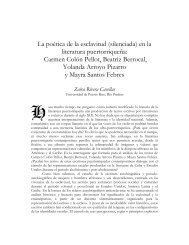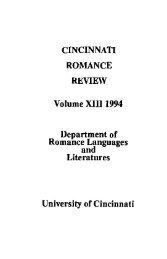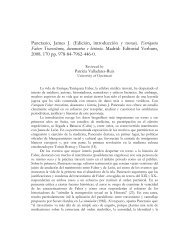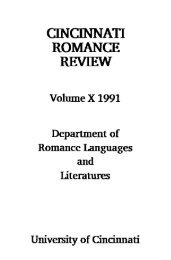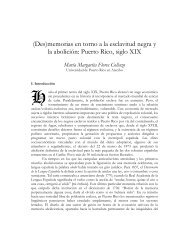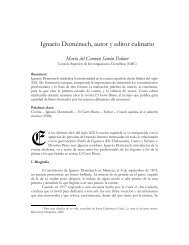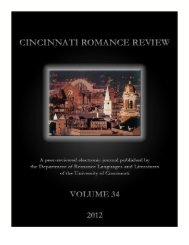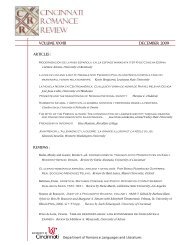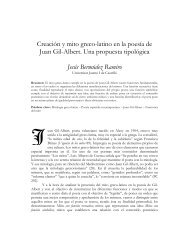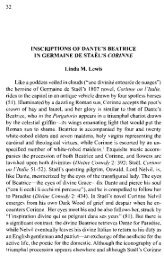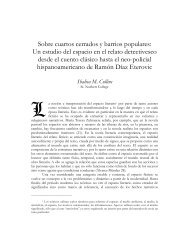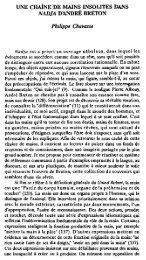Volume 30 (2011) - Cincinnati Romance Review
Volume 30 (2011) - Cincinnati Romance Review
Volume 30 (2011) - Cincinnati Romance Review
Create successful ePaper yourself
Turn your PDF publications into a flip-book with our unique Google optimized e-Paper software.
WRITING AFRICANS OUT OF THE RACIAL HIERARCHY<br />
became policy during the Porfiriato as indigenous people were pushed to the margins of<br />
society and in some cases became victims of genocidal policy.<br />
Mexico was not unique in adopting North Atlantic racial ideologies. From the<br />
late 19th through the early 20th century intellectuals throughout Latin America wrestled<br />
with them. Diaz’s científicos were not unusual in accepting and even expanding upon<br />
racist Euro-American constructs of race. Domingo Faustino Sarmiento, for example,<br />
wrote extensively on what he saw as the lamentable racial makeup of his country,<br />
Argentina. He not only complained about indigenous people and Africans, the two<br />
groups that he saw as the greatest polluters of the Argentine nation, but also of<br />
Argentina’s Spanish heritage, which he believed to be inferior to Northern and Western<br />
European stock. His ideas tangibly shaped the modern Argentine nation. Under his<br />
presidency and those that followed it Argentina was “whitened” through a massive<br />
campaign to encourage European immigration and as a result of the Argentine army’s<br />
near annihilation of the indigenous population during the final conquest of the desert<br />
(Helg).<br />
New Treatises on Race in Latin America<br />
With the onset of worldwide economic depression in 1929 the Latin American<br />
export-based economies sank, and with them the elitist regimes that emphasized<br />
whitening (Andrews 151, 157). Political instability was replaced by the rise of populist<br />
regimes, which emphasized the shared class interest of common people regardless of<br />
their race (Andrews 157). The racial ideologies proposed by Gamio, Vasconcelos and<br />
Paz were not part of a uniquely Mexican phenomenon. They were part of a larger<br />
ideological movement in Latin America known as racial democracy that emerged<br />
primarily during the 19<strong>30</strong>s. Accompanying the populist regimes that rose to power and<br />
particularly inspired by the nationalism of the revolutions that occurred in Cuba, Brazil,<br />
and Mexico, racial democracy attempted to impart the egalitarian ideals influencing<br />
politics on society as well. At its core, racial democracy proposed a kind of color<br />
blindness. Beyond that, however, it also preached that the diversity of Latin American<br />
countries made them stronger rather than weaker. The exact ideologies varied<br />
somewhat by country. Brazilian racial democracy emphasized the positive elements of<br />
the African population, while in Mexico it focused on the triumphs of indigenous<br />
civilizations, for example (Holt xi). Throughout Latin America, however, new racial<br />
treatises preached that racial mixing would contribute to a new and superior race.<br />
This attempt to upset North Atlantic racial ideologies occurred somewhat earlier<br />
in Mexico than elsewhere because of the political and economic tumult caused by the<br />
onset of the Mexican Revolution in 1910.The Mexican Revolution ushered in a new way<br />
of thinking about the nation in Mexico, as well as new ways of thinking about what it<br />
meant to be Mexican. Within the North Atlantic white supremacist framework,<br />
<strong>Cincinnati</strong> <strong>Romance</strong> <strong>Review</strong> <strong>30</strong> (Winter <strong>2011</strong>): 172-183.<br />
175



